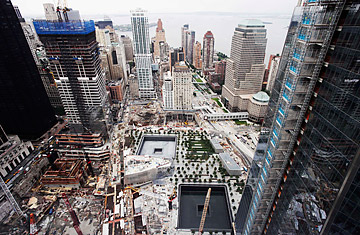
A view of the construction of the World Trade Center complex on Aug. 25, 2011
(3 of 3)
Where would the victims' names go? In what order? How would the waterfalls flow? What about the museum? Part of Arad's memorial served as the ceiling for Calatrava's underground transportation hub — a massive subway and train station designed to accommodate an estimated 250,000 commuters every day — and the two architects' designs didn't match up. The decade crept by. In a September 2008 Wall Street Journal op-ed, Mayor Michael Bloomberg called the project "frustratingly slow" and demanded the memorial be finished by the 10th anniversary of the attacks. The Port Authority reluctantly agreed.
"We made the announcement and after we said it, we just kind of looked at each other," says Ward. "Did I ever think we could accomplish it? Honestly, not in my wildest dreams."
Because the transit hub sits underneath part of the memorial, construction — which usually starts from the bottom and goes up — would have to be reversed in order to make the deadline. "We're essentially building from the ceiling down," explains Ward. "But we are building."
Today, the World Trade Center is the site of continuous, frenzied activity. To stay on schedule, the construction must go on 24 hours a day, stopping only during bad weather and, as was the case in May, when President Obama visits. "It's extremely hard and grueling," says Brian Lyons, a superintendent with Tishman Construction, the company that is building several of the Port Authority's projects, including One World Trade Center. "You're either climbing deep down into the ground or way up into the sky. There are so many different layers it's absolutely mind-boggling."
Like many of the 3,200 workers on site at any one time, Lyons works six or seven days a week, often for more than 12 hours at a stretch. He's helped construct Seven World Trade Center, one of Silverstein's buildings, successfully completed in 2006; One World Trade Center; and several other projects. He is currently overseeing the construction of the transportation hub. "We're blasting, chopping and drilling. Meanwhile, there's a live subway that passes us every four minutes during the day," he says. "Because of that, most of the work is done in the middle of the night."
One World Trade Center will cost $3.2 billion to build — that's a lot more than its original price tag of $350 million — but it's currently 83 stories tall and rising at the rate of a floor a week. In May, Condé Nast agreed to a $2 billion lease, giving the project the financial backing that it has needed for so long. The building's rust-colored skeleton can be seen, creeping up slowly to take its place along the Manhattan skyline.
"I had no idea they had built so much," says Keith Ellison, 49, from Bend, Ore. Ellison had seen Ground Zero only a few months after the initial attacks and returned last week to see it again. "When I first went, they'd blocked off everything so I couldn't see much," he says. "I hadn't heard anything about progress that was being made so I thought it would still be the same."
It's now just days before Sept. 11, and the 9/11 Memorial is almost finished. The waterfalls have been done since the spring, and the plaza was completed mid-August. Port Authority workers scramble about like hostesses about to throw an elaborate party. They're checking every stone and making sure every light bulb is screwed in tightly. Last week, they finally planted the shrubbery.
"The unveiling can't be like Spider-Man," says Ward, referring to the recent Broadway production beset by so many problems. "We can't have an opening night where something doesn't work or the curtain doesn't rise properly. This is a one-shot deal."
And around the memorial, construction on the rest of the World Trade Center is finally moving along. The buildings will be different, of course — sleek and graceful titans that will do their best to replace what we once loved. The financial district is thriving again, with new restaurants, wine stores, produce markets and dental clinics popping up around the steel skeletons, providing services for those who have decided to live their lives there in the wake of tragedy. It may feel strange, even a little bit wrong, to think about the future during a week so dedicated to remembering the past. But that is the beauty of this city. This country. A decade ago, a part of us was reduced to rubble. Not only do we find ourselves standing up again, but growing taller by the day. Every year that passes will bring a Sept. 11. But when it's over, there will always be another Sept. 12.
